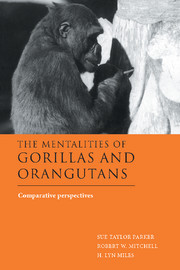Book contents
- Frontmatter
- Contents
- List of contributors
- Preface
- Acknowledgments
- I Comparative evolutionary and developmental perspectives on gorillas and orangutans
- II Cognition and tool use in gorillas and orangutans
- III Communication in gorillas and orangutans
- 10 Symbolic communication with and by great apes
- 11 The development of spontaneous gestural communication in a group of zoo-living lowland gorillas
- 12 Early sign-language acquisition: comparisons between children and gorillas
- 13 Early sign performance in a free-ranging,adult orangutan
- IV Social cognition in gorillas and orangutans
- V Epilogue
- Index of authors
- Index of subjects
10 - Symbolic communication with and by great apes
Published online by Cambridge University Press: 20 October 2009
- Frontmatter
- Contents
- List of contributors
- Preface
- Acknowledgments
- I Comparative evolutionary and developmental perspectives on gorillas and orangutans
- II Cognition and tool use in gorillas and orangutans
- III Communication in gorillas and orangutans
- 10 Symbolic communication with and by great apes
- 11 The development of spontaneous gestural communication in a group of zoo-living lowland gorillas
- 12 Early sign-language acquisition: comparisons between children and gorillas
- 13 Early sign performance in a free-ranging,adult orangutan
- IV Social cognition in gorillas and orangutans
- V Epilogue
- Index of authors
- Index of subjects
Summary
CAN AN APE LEARN LANGUAGE?
In 1887, Müller challenged Darwin to demonstrate the truth of human evolution by teaching language to an ape. More than 100 years later, scientists are no longer worried about supporting claims of human evolution, but they are still teaching apes aspects of human language and discerning what apes understand. With more than 30 great apes from all four species exposed to some level of language learning and human culture, it is possible to make preliminary comparisons among the great apes. The abilities of chimpanzees and bonobos have been extensively reviewed (Desmond, 1979; Gardner, Gardner, & Van Cantfort, 1989; Savage-Rumbaugh, 1991; Wallman, 1992), but less is known about gorillas and orangutans (Ristau, 1996). In this chapter, I summarize the ape language studies, compare the language abilities of all great ape species, and discuss specific issues such as methodology, vocabulary, symbolic capacity, communicative competence, reference, and grammar. To begin, I describe briefly three types of language-learning studies: those based on speech, those based on gesture, and those based on arbitrary visual symbols.
SPEECH STUDIES
Perhaps the first study to teach an ape some aspect of human language was Garner's (1900, p. 138) attempt to teach the chimpanzee Moses four words with “a bribe of corned beef”: the English “mamma,” the French “feu,” the German “wie,” and the Nkami “nkgwe”. Moses learned to say “feu,” and imitated the mouth movements of “mamma,” but was less successful with the other two sounds.
- Type
- Chapter
- Information
- The Mentalities of Gorillas and OrangutansComparative Perspectives, pp. 197 - 210Publisher: Cambridge University PressPrint publication year: 1999
- 11
- Cited by



